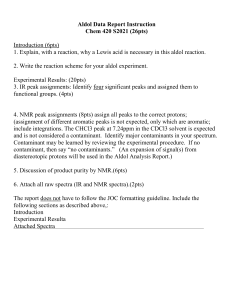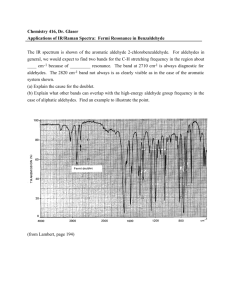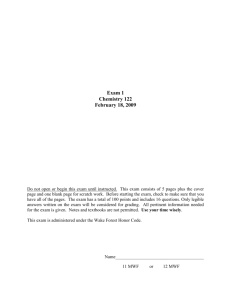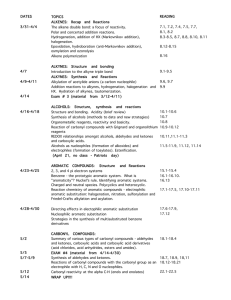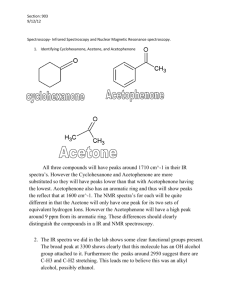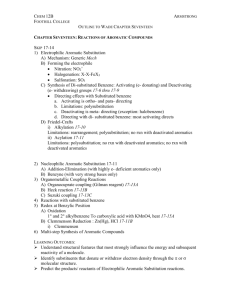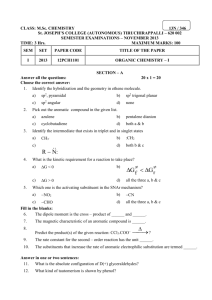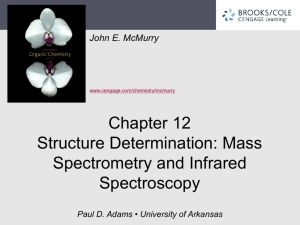ChemActivity 9 - Concordia Faculty Homepages
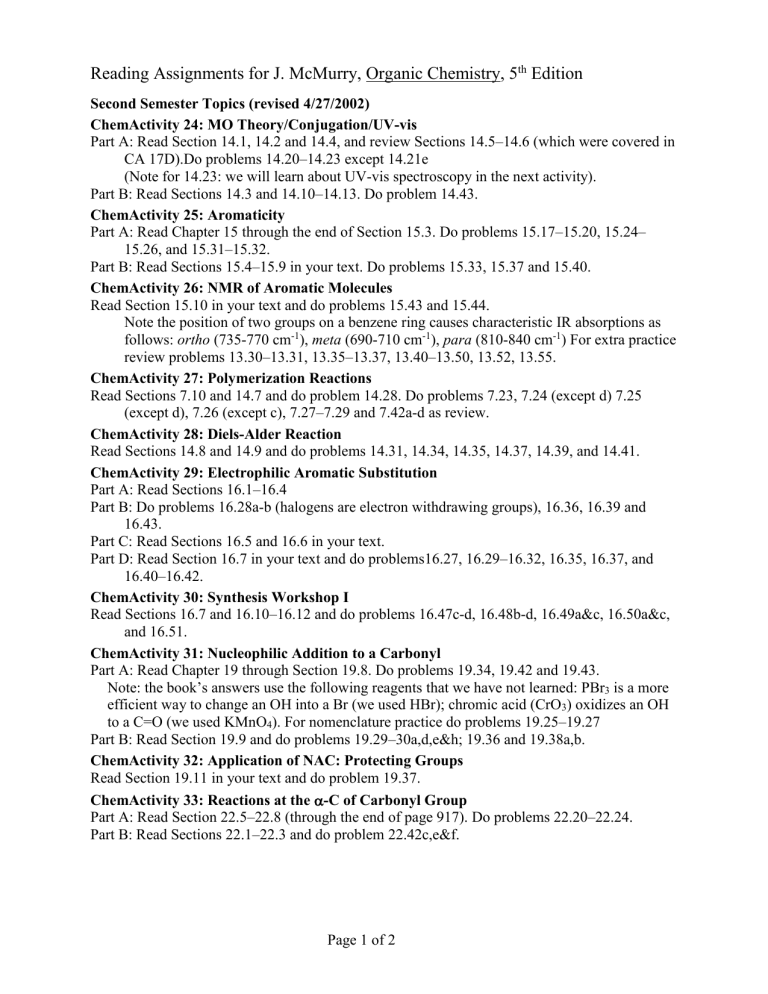
Reading Assignments for J. McMurry, Organic Chemistry, 5
th
Edition
Second Semester Topics (revised 4/27/2002)
ChemActivity 24: MO Theory/Conjugation/UV-vis
Part A: Read Section 14.1, 14.2 and 14.4, and review Sections 14.5–14.6 (which were covered in
CA 17D).Do problems 14.20–14.23 except 14.21e
(Note for 14.23: we will learn about UV-vis spectroscopy in the next activity).
Part B: Read Sections 14.3 and 14.10–14.13. Do problem 14.43.
ChemActivity 25: Aromaticity
Part A: Read Chapter 15 through the end of Section 15.3. Do problems 15.17–15.20, 15.24–
15.26, and 15.31–15.32.
Part B: Read Sections 15.4–15.9 in your text. Do problems 15.33, 15.37 and 15.40.
ChemActivity 26: NMR of Aromatic Molecules
Read Section 15.10 in your text and do problems 15.43 and 15.44.
Note the position of two groups on a benzene ring causes characteristic IR absorptions as follows: ortho (735-770 cm -1 ), meta (690-710 cm -1 ), para (810-840 cm -1 ) For extra practice review problems 13.30–13.31, 13.35–13.37, 13.40–13.50, 13.52, 13.55.
ChemActivity 27: Polymerization Reactions
Read Sections 7.10 and 14.7 and do problem 14.28. Do problems 7.23, 7.24 (except d) 7.25
(except d), 7.26 (except c), 7.27–7.29 and 7.42a-d as review.
ChemActivity 28: Diels-Alder Reaction
Read Sections 14.8 and 14.9 and do problems 14.31, 14.34, 14.35, 14.37, 14.39, and 14.41.
ChemActivity 29: Electrophilic Aromatic Substitution
Part A: Read Sections 16.1–16.4
Part B: Do problems 16.28a-b (halogens are electron withdrawing groups), 16.36, 16.39 and
16.43.
Part C: Read Sections 16.5 and 16.6 in your text.
Part D: Read Section 16.7 in your text and do problems16.27, 16.29–16.32, 16.35, 16.37, and
16.40–16.42.
ChemActivity 30: Synthesis Workshop I
Read Sections 16.7 and 16.10–16.12 and do problems 16.47c-d, 16.48b-d, 16.49a&c, 16.50a&c, and 16.51.
ChemActivity 31: Nucleophilic Addition to a Carbonyl
Part A: Read Chapter 19 through Section 19.8. Do problems 19.34, 19.42 and 19.43.
Note: the book’s answers use the following reagents that we have not learned: PBr
3
is a more efficient way to change an OH into a Br (we used HBr); chromic acid (CrO
3
) oxidizes an OH to a C=O (we used KMnO
4
). For nomenclature practice do problems 19.25–19.27
Part B: Read Section 19.9 and do problems 19.29–30a,d,e&h; 19.36 and 19.38a,b.
ChemActivity 32: Application of NAC: Protecting Groups
Read Section 19.11 in your text and do problem 19.37.
ChemActivity 33: Reactions at the
-C of Carbonyl Group
Part A: Read Section 22.5–22.8 (through the end of page 917). Do problems 22.20–22.24.
Part B: Read Sections 22.1–22.3 and do problem 22.42c,e&f.
Page 1 of 2
ChemActivity 34: Base Catalyzed Aldol Reactions
Part A: Read Sections 23.1–23.3 in your text and do problem 23.25a,e&f.
Part B: Do problems 23.25c,b&d and 23.35b-d.
Part C: Read Sections 23.24–23.27 in your text. Do problems 23.26, 23.28–23.30, 23.32, and
23.33.
ChemActivity 35: Acid Catalyzed Aldol Reactions
Read Section 23.14 in your text
ChemActivity 36:
-Unsaturated Carbonyl Compounds
Part A: Read Sections 19.14–19.15 in your text and do problem 19.28.
Part B: Do problem 19.39(except a&g).
ChemActivity 37: Michael Additions
Read Section 23.11 in your text.
ChemActivity 38: Acidity of Phenols
Part A: Do problems 17.24a-e, 17.27, 17.29, 17.31, and 17.33
Part B: Read Section 17.3 in your text. Do problems 17.41, 17.49, and 17.52. Review NMR and do problems 17.54–17.62. Recall that a deuterium (D) does not show up on an NMR spectrum. Addition of D
2
O to a compound replaces all H’s with pKa < 14 with a D.
ChemActivity 39: Nucleophilic Aromatic Substitutions
Read Section 16.8.
ChemActivity 40: Carboxylic Acids
Part A: Read Chapter 20. Do problems 20.17–20.21, 20.22a-d, 20.23, 20.24, 20.28–20.31 and
20.38.
Part B: Read Chapter 21, Sections 21.1 and 21.6–21.8. Do NMR problems 20.47, 20.48 at the end of Chapter 20, and problems 21.35, 21.36, 21.40, 21.42a-g, 21.45, 21.48 and 21.56
ChemActivity 41: Carboxylic Acid Derivatives
Part A: Read Sections 21.2–21.4 and do problems 21.41, 21.43, and 21.44.
Part B: Read Section 21.5 and do problems 21.51, 21.52b-d, 21.57 (an aromatic NO
2
can be oxidized to an aromatic NH
2
without effecting an aromatic ester group), and 21.58.
ChemActivity 42: Claisen Reactions
Part A: Read Sections 23.8 and 23.10. Do problem 23.40 as a review of Michael reactions.
Part B: Read Section 23.9. Do problems 23.36 and 23.37.
Part C: Review all of Chapter 23 except Section 23.12.
ChemActivity 43: Decarboxylation
Read Section 22.8 in your text. Do problems 22.26a, 22.35, 22.36, and 22.38.
ChemActivity 44: Synthesis Workshop II
Review Section 22.8 in your text and do problems 22.27–22.30.
ChemActivity 45: Amines and Amino Acids
Part A: Read Chapter 24 through the end of Section 24.5. Do problems 24.23–24.25, and 24.38–
24.40.
Part B: Read Sections 24.6 and 24.7. Do problems 24.28a,b,d,e; 24.29d,e; 24.30a,c,e,f; and
24.33(except d).
ChemActivity 46: Polypeptides and Proteins
Part A: Read Chapter 26 through the end of Section 26.2, plus 26.5 and 26.6. Do problems 26.33 and 26.34.
Part B: Read Sections 26.12 through the end of the chapter. Do problems 26.47, 26.61, and
26.64.
Page 2 of 2

